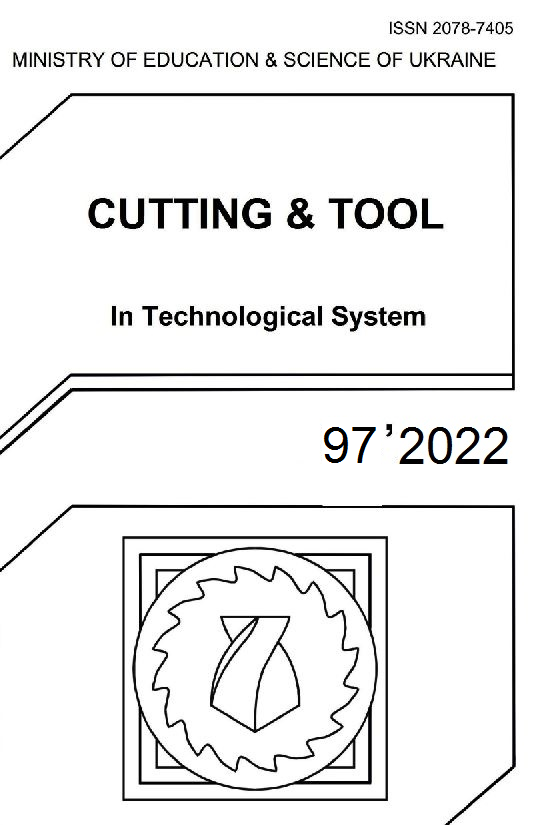THE NATURE OF THE FORMATION OF SURFACE MICRO-ROUGHNESS IN VIBRATION FINISHING AND GRINDING PROCESSING
DOI:
https://doi.org/10.20998/2078-7405.2022.97.09Keywords:
vibration treatment, abrasive granule, processed part, collision between granule and processed part, collision angle, surface micro-roughness, velocity hodographsAbstract
The main aspects related to the nature of the formation of surface micro-roughness during vibration finishing and grinding processing are given. It is indicated that the material removal from the surface of the part occurs as a result of the combined action of micro-cutting processes, chipping of metal particles during repeated deformation of the processed surface areas, their fatigue and destruction, the formation, destruction and removal of secondary structures, and adhesion phenomena. It is noted that the real surface after vibration treatment is a set of roughnesses of a certain size, shape and direction. It is defined that the micro-roughness of the surface of the part during vibration finishing and grinding is formed in the form of traces from numerous impacts of abrasive granules on the surface of the part. The largest value of the granule penetration into the processed surface is determined, that makes it possible to characterize the trace from plastic compression in the zone of collision between the granule and the part. The technique and study of the mechanism of formation of surface microroughness is considered. An expression is determined for the normal component of the impact force, which characterizes the main effect on the mechanism of micro-roughness formation. The value of penetration of the granule into the metal of the part is determined. The study showed that the surface micro-roughness during vibration treatment is formed by impacts of granules on the part at different meeting angles. The traces from action of straight and oblique impacts are established. The average height of micro-roughness is calculated. According to the hodographs, the normal velocities of abrasive granules and parts are determined. The average value of the angle of impact of the granules with the part at any point of the trajectory of their movement is also determined. It was revealed that the velocities of granules and parts change in magnitude and direction during one period of the reservoir oscillation, reaching their limiting values, which are proportional to the reservoir movement velocities. The degree of proportionality is expressed by the similarity coefficient for the granule and the part. The average similarity coefficient was also determined by the points of the hodograph. The average values of the movement velocities of the granule and the part in the reservoir are obtained. The minimum and maximum value of the granule penetration into the surface of the part is established. The formulas for the limiting values of the granule penetration depth are given, taking into account the coefficient of ellipticity. The results of calculations for determining the height of micro-roughness of the processed part surface are presented. A formula is obtained for determining the surface micro-roughness during vibration finishing and grinding processing.
References
Jashhericyn P.I., Martynov A.N. Chistovaja obrabotka detalej v mashinostroenii. Minsk: Vishjejshaja shk., 1983. 191 p.
Kartashov I.N., Shainskij M.E., Vlasov V.A. Obrabotka detalej svobodnymi abrazivami v vibrirujushhih rezervuarah. Kyiv: Vishha shk., 1975. 188 p.
Mitsyk А.V., Fedorovich V.A., Grabchenko А.І. Mechano-physico-chemical modeling of the process of destruction of the part surface in a free abrasive medium. Cutting & Tools in Technological System. Kharkiv, NTU «KhPІ». 2020. № 92. pp. 62 – 67. http://doi.org/10.20998/2078–7405.2020.92.08
Babichev A.P., Babichev I.A. Osnovy vibracionnoj tehnologii: monografija. Rostov-na-Donu: Izd-vo DGTU, 2008. 694 p.
Kulakov Ju.M., Hrulkov Ju.M. Otdelochno-zachistnaja obrabotka detalej. Moskva: Mashinostroenie, 1979. 216 p.
Mitsyk A.V., Fedorovich V.A., Grabchenko А.І. The effect of a shock wave in an oscillating working medium during vibration finishing-grinding processing. Cutting & Tools in Technological System. Kharkiv, NTU «KhPІ». 2020. № 93. pp. 43 – 55. http://doi.org/10.20998/2078-7405.2020.93.06
Shainskij M.E. Issledovanie dekorativnogo shlifovanija i polirovanija stal'nyh detalej v vibrirujushhih rezervuarah: dis. … kand. tehn. nauk: 05.02.08. Lviv, 1967. 171 p.
Instrument dlja obrobky detalej vil'nymy abrazyvamy: monografija / M.O. Kalmykov, T.O. Shumakova, V.B. Strutynskyi, L.M. Lubenska. Kyiv – Luhansk: «Noulidzh», 2010. 214 p.
Vlasov V.A. Issledovanija mehaniki vzaimodejstvija shlifoval'nyh tel i stal'nyh detalej v vibrirujushhih rezervuarah: dis. … kand. tehn. nauk: 05.02.08. Kharkiv, 1974. 226 p.
Downloads
Published
Issue
Section
License
Copyright Notice
Authors who publish with this Collection agree to the following terms:
1. Authors retain copyright and grant the Collection right of first publication with the work simultaneously licensed under a Creative Commons Attribution License that allows others to share the work with an acknowledgement of the work's authorship and initial publication in this Collection.
2. Authors are able to enter into separate, additional contractual arrangements for the non-exclusive distribution of the Collection's published version of the work (e.g., post it to an institutional repository or publish it in a book), with an acknowledgement of its initial publication in this Collection.
3. Authors are permitted and encouraged to post their work online (e.g., in institutional repositories or on their website) prior to and during the submission process, as it can lead to productive exchanges, as well as earlier and greater citation of published work.

